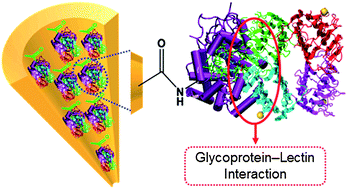Biomolecular conjugation inside synthetic polymer nanopores viaglycoprotein–lectin interactions
Abstract
We demonstrate the supramolecular bioconjugation of concanavalin A (Con A)

* Corresponding authors
a
Technische Universität Darmstadt, Fachbereich Material-u. Geowissenschaften, Fachgebiet Materialanalytik, Petersenstraβe 23, Darmstadt, Germany
E-mail:
m.ali@gsi.de
Fax: +49 6159 713266
Tel: + 49 6159 712177
b Depto. de Física Aplicada, Universidad Politécnica de Valencia, Valencia, Spain
c Department of Chemistry, Johannes Gutenberg-Universität, Duesbergweg 10-14, Mainz, Germany
d Dept. de Física de la Terra i Termodinàmica, Universitat de València, Burjassot, Spain
e Department of Physics and Astronomy, University of California, Irvine, California, USA
f GSI Helmholtzzentrum für Schwerionenforschung, Planckstraβe 1, Darmstadt, Germany
We demonstrate the supramolecular bioconjugation of concanavalin A (Con A)

 Please wait while we load your content...
Something went wrong. Try again?
Please wait while we load your content...
Something went wrong. Try again?
M. Ali, P. Ramirez, M. N. Tahir, S. Mafe, Z. Siwy, R. Neumann, W. Tremel and W. Ensinger, Nanoscale, 2011, 3, 1894 DOI: 10.1039/C1NR00003A
To request permission to reproduce material from this article, please go to the Copyright Clearance Center request page.
If you are an author contributing to an RSC publication, you do not need to request permission provided correct acknowledgement is given.
If you are the author of this article, you do not need to request permission to reproduce figures and diagrams provided correct acknowledgement is given. If you want to reproduce the whole article in a third-party publication (excluding your thesis/dissertation for which permission is not required) please go to the Copyright Clearance Center request page.
Read more about how to correctly acknowledge RSC content.
 Fetching data from CrossRef.
Fetching data from CrossRef.
This may take some time to load.
Loading related content
